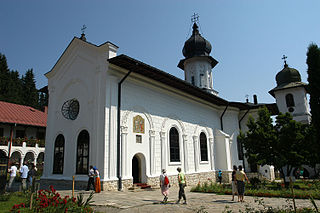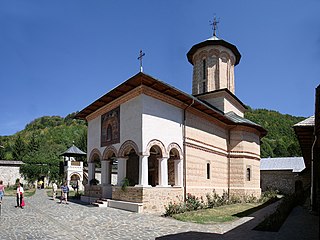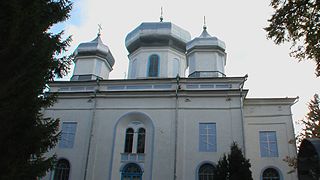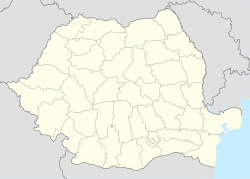
The Putna monastery is a Romanian Orthodox monastery, one of the most important cultural, religious and artistic centers established in medieval Moldavia; as with many others, it was built and dedicated by Stephen the Great. Putna was founded on the lands perambulated by the Putna. Stephen the Great is famous for building and influencing the building of dozens of churches and monasteries all over Moldavia. The Putna Monastery houses the tombs of Stephen – nowadays, a place of pilgrimage –, and several of his family members. The icon veils and tombstones are held as fine examples of Moldavian art in Stephen the Great's time.

The Antim Monastery is a Romanian Orthodox church located in Bucharest, Romania on Mitropolit Antim Ivireanu Street, no. 29. It was built between 1713 and 1715 by Saint Antim Ivireanu, at that time a Metropolitan Bishop of Wallachia. The buildings were restored by Patriarch Justinian Marina in the 1960s. As of 2005, there were 7 monks living in the Monastery. The monastery also hosts a museum with religious objects and facts about the life of Antim Ivireanu.

The Agapia Monastery is a Romanian Orthodox nunnery located 9 km west of Târgu Neamț, in the commune of Agapia, Neamț County. It was built between 1641 and 1643 by Romanian hetman Gavriil Coci, brother of Vasile Lupu. The church was painted by Nicolae Grigorescu between 1858 and 1861. It is one of the largest nunneries in Romania, having 300–400 nuns and ranking second place in population after Văratec Monastery.

Mănăstirea Trei Ierarhi is a seventeenth-century monastery located in Iași, Romania. The monastery is listed in the National Register of Historic Monuments and included on the tentative list of UNESCO World Heritage Sites.

Valea Mare is a commune in Covasna County, Transylvania Romania. It is composed of a single village, Valea Mare, which was part of Barcani Commune before being split off in 1999.

Polovragi is a commune in Gorj County, Oltenia, Romania. It is composed of two villages, Polovragi and Racovița.

Saint Cleopa (Ilie) of Sihăstria was an abbot of the Sihăstria Monastery. He was a well-known spiritual representative of the Romanian Orthodox Church.

Frâncești is a commune located in Vâlcea County, Oltenia, Romania. It is composed of nine villages: Băluțoaia, Coșani, Dezrobiți, Frâncești, Genuneni, Mănăilești, Moșteni, Surpatele, and Viișoara.
Maglavit is a commune in Dolj County, Oltenia, Romania. It is composed of two villages, Hunia and Maglavit.

Vânători-Neamț is a commune in Neamț County, Western Moldavia, Romania. It is composed of four villages: Lunca, Mânăstirea Neamț, Nemțișor, and Vânători-Neamț.

The Golia Monastery is a Romanian Orthodox monastery located in Iaşi, Romania. The monastery is listed in the National Register of Historic Monuments. In 2012, the conservation of the Monastery was awarded the European Union Prize for Cultural Heritage / Europa Nostra Award.

Constantin S. Nicolăescu-Plopșor or Nicolaescu-Plopșor, sometimes shortened to N. Plopșor, was a Romanian historian, archaeologist, anthropologist and ethnographer, also known as a folkorist and children's writer, whose diverse activities were primarily focused on his native region of Oltenia. A student and disciple of Vasile Pârvan at the University of Bucharest, he had a youthful activity collecting and publishing Oltenian songs and poetry, being the first to document Romanian folklore as produced during the peasants' revolt of 1907, and committing to writing the regional variants of Miorița ballad. Increasingly interested in the Balkans' prehistoric period, he researched various Paleolithic, Mesolithic, and Neolithic sites in his native country, placing them in a larger European context while producing his own systems of Prehistoric chronology and typology. His main contributions to archaeology include the classification of Oltenian microliths, the study of local cave paintings, and the disputed claim that a site in Tetoiu evidenced a regional contribution to anthropogenesis.

St.Theodora of Sihla, Teodora or Bohdanna of the Carpathians is a Christian ascetic and Romanian Orthodox saint, commemorated on 7 August.

Petrache Lupu was a shepherd from Maglavit commune, who claimed to have had divine visions. In 1935 a mass phenomenon began, with Maglavit becoming a Christian pilgrimage place for crowds of people. The Maglavit Monastery is built in the area.

Hîrbovăț monastery is a monastery of Moldova, located north of the village of Hîrbovăț, under the jurisdiction of the Diocese of Ungheni and Nisporeni of the Metropolis of Chișinău and All Moldova.

The Snagov Monastery, also known as the Vlad Țepeș Monastery is a medieval monastery and important historical monument located in southern Romania in the county of Ilfov, on an island in the northern reaches of Lake Snagov, belonging to the commune of Snagov, and in geographical proximity to the village of Siliștea Snagovului, in the Gruiu commune.

The church of Archangel Michael in Săpânța-Peri from the village of Săpânța in the region of Maramureș, Romania is the tallest wooden church in the world. A representative of the characteristic wooden churches of Maramureș with double eaves, the church continues the tradition of the old Orthodox monastery in Peri, the ruins of which are now found in the area of Hrushove in Ukraine.

Cernica Monastery is a Romanian Orthodox monastery located on the shore of Lake Cernica. Situated in Ilfov County, just outside Bucharest, it is part of Pantelimon town. It is listed as a historic monument.

Căldărușani Monastery is a Romanian Orthodox monastery located in the town of Gruiu, Ilfov County, Romania, by the Căldărușani Lake. The monastery complex is listed as a historic monument and includes several significant buildings and a rich collection of Romanian art.



















